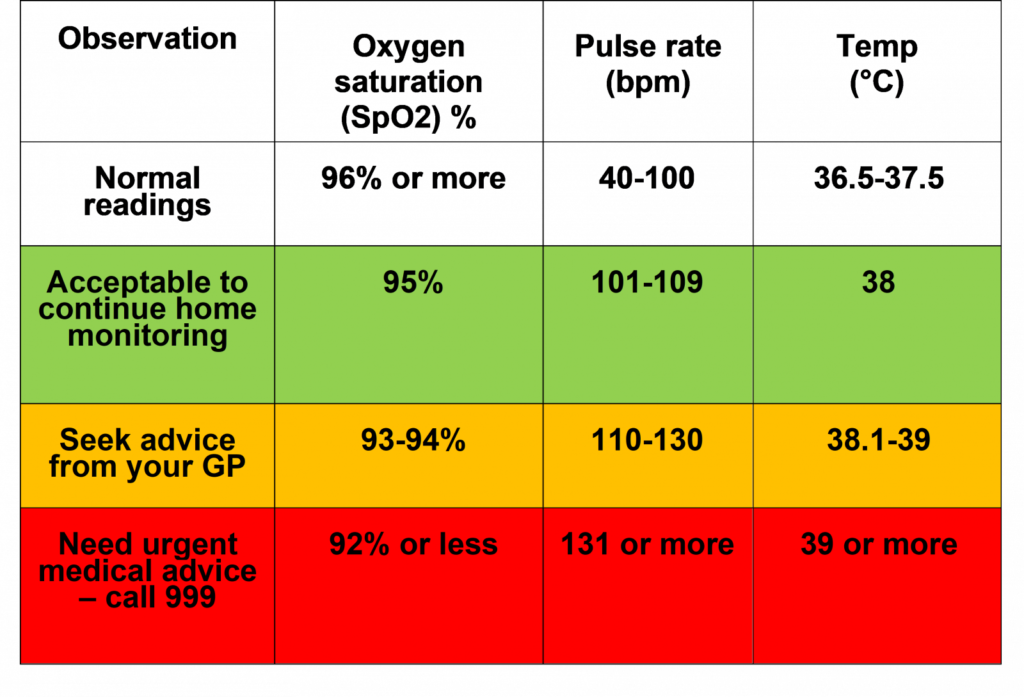Why have I been told to use a pulse oximeter?
You may have been told by your doctor to use a pulse oximeter because you are recovering from COVID-19, or because you are a patient who is at higher risk of suffering with COVID-19. Using a pulse oximeter is a good way of making sure your breathing levels aren’t worsening.

What does a pulse oximeter do?
It measures how fast your heart is beating as well as checking how well you are breathing, it does this by checking how much oxygen is in your blood.
An ideal oxygen level is between 96% and 99% and an ideal heart rate is between 50 and 90 beats per minute (bpm).
The oxygen level may be lower in some people with lung conditions, even when they are feeling well. If you have an existing lung condition, please check with your doctor about what your readings should be.
To view guidance in a language that isn’t English, please click here.
How to use a pulse oximeter
Follow these steps to make sure the pulse oximeter gives the correct reading:
- Remove any nail polish or false nails.
- Warm your hand.
- Make sure you have been resting for at least five minutes before taking the reading.
- Rest your hand on your chest at the level of your heart and hold it still.
- Switch the pulse oximeter on and place it on your finger. It works best on your middle or index finger of either hand, it should not be used on your ear.
- The reading takes time to steady. Keep the pulse oximeter in place for at least a minute, or longer if the reading keeps changing.
- Record the highest result once the reading has not changed for five seconds.
- Be careful to identify which reading is your heart rate and which is your oxygen level.
The best way to track your heart rate and oxygen level is by taking a reading three times a day at the same time every day and keeping a diary of each reading.
Download a measurement diary by clicking here.
If you are recovering from COVID-19 and need advice on self-isolation and treating COVID-19 symptoms, please visit the NHS website.
What to do if you experience any of the following symptoms
Attend your nearest A&E or call 999 immediately if you have one or more of the following symptoms and tell the operator you may have coronavirus:
- You are unable to complete short sentences when at rest due to breathlessness
- Your breathing suddenly worsens within an hour
- Your blood oxygen level is 92% or less. Check your blood oxygen level again straight away – if it’s still 92% or below, go to A&E immediately or call 999
OR if these more general signs of illness worsen:
- you are coughing up blood
- you feel cold and sweaty with pale or blotchy skin
- you develop a rash that does not fade when you roll a drinking glass over it
- you collapse or faint
- you become agitated, confused or very drowsy
- you have stopped peeing or are peeing much less than usual.
If you have your pulse oximeter, please give the oxygen saturation reading to the 999 operator when you speak to them.
Ring 111 as soon as possible if you have one or more of the following and tell the operator you may have coronavirus:
- You slowly start feeling more unwell or more breathless
- You are having difficulty breathing when getting up to go to the toilet or similar
- If you use the pulse oximeter, your blood oxygen level is 94% or 93% when sitting or lying down and remains at this level after being rechecked within an hour
- You sense that something is wrong (general weakness, severe tiredness, loss of appetite, reduced urine output, unable to care for yourself – simple tasks like washing and dressing or making food)
If your blood oxygen level is usually below 95% but it drops below your normal level, call 111 for advice. Have your diary readings available.



Leave a Reply